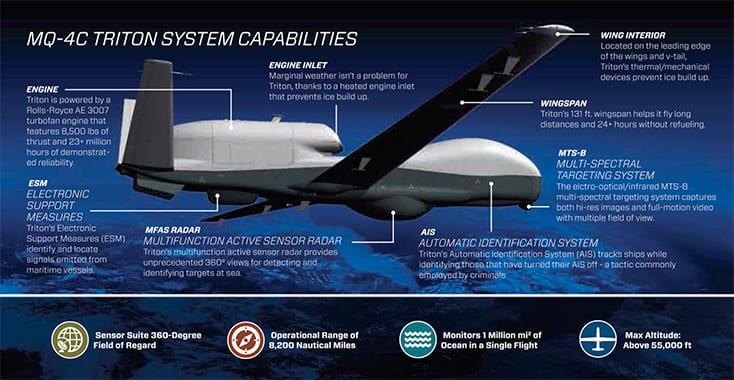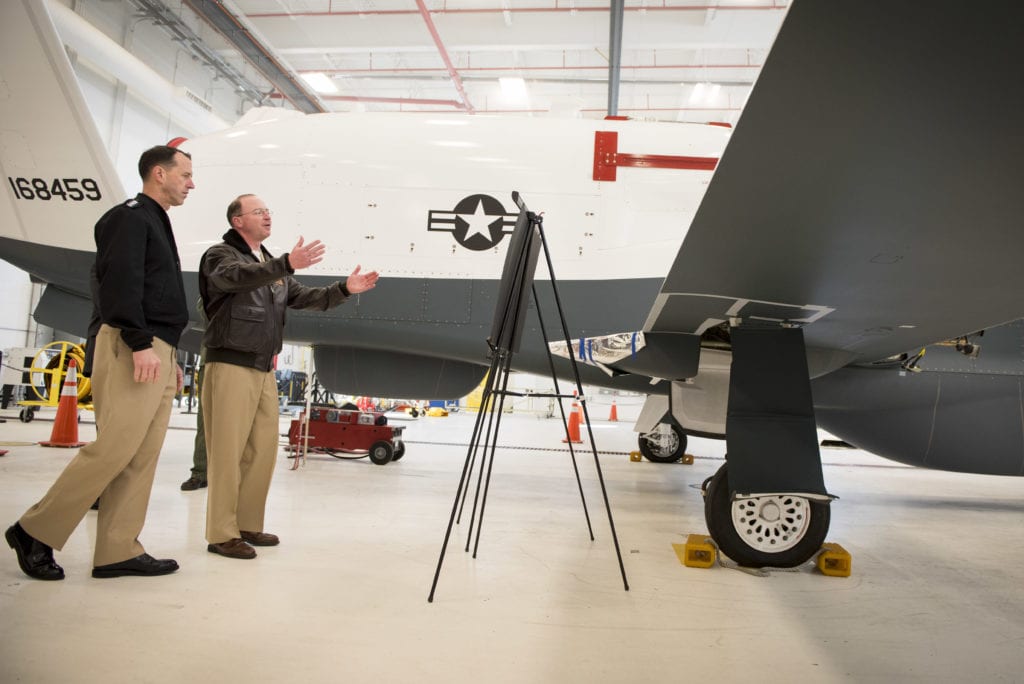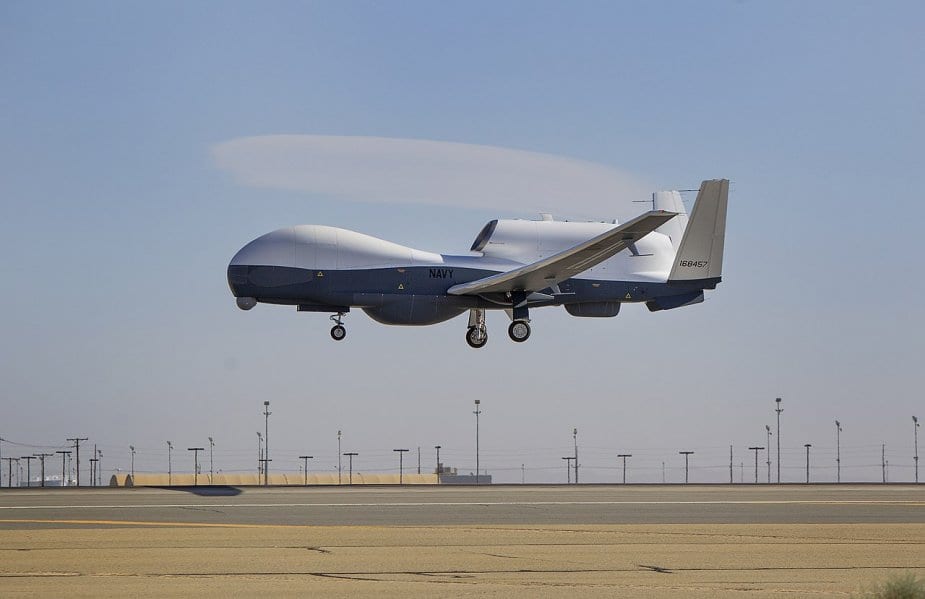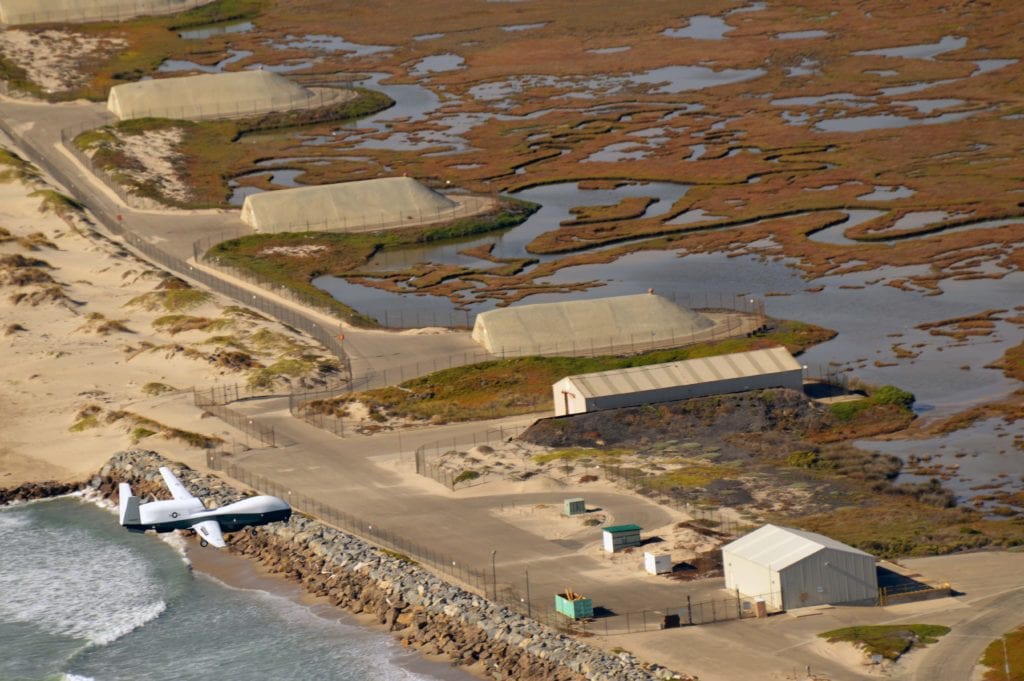
In January, the U.S. Navy’s newest surveillance aircraft, the Northrop Grumman-built MQ-4C Triton, a high-altitude, long-endurance unmanned aerial vehicle (UAV), embarked on its first deployment, a move to demonstrate what the Navy calls early operational capability.
Two MQ-4Cs assigned to Unmanned Patrol Squadron 19 (VUP-19), the first Triton squadron, deployed to Andersen Air Force Base on Guam and were in place by Jan. 26 to fly missions in support of the U.S. 7th Fleet.
Check out the digital edition of the May Seapower magazine here.
“VUP-19 is operating Triton to further develop the concept of operations and fleet learning associated with operating a high-altitude, long-endurance system in the maritime domain,” Capt. Dan Mackin, the Navy’s Triton program manager, said in response to a query from
Seapower. “The squadron plans to conduct multiple flights per month in support of Commander Task Force 72, 7th Fleet and Indo-Pacific Command.”
“The fielding of the Navy’s premier unmanned aircraft system and its additive, persistent, multisensor data collection and real-time dissemination capability will revolutionize the way maritime intelligence, surveillance and reconnaissance [ISR] is performed,” Mackin said in a Jan. 26 Navy release.

“While developing the concept of operations, the MQ-4C Triton is actively conducting missions that are complementing the P-8A Poseidon,” said Cmdr. Kim DaCosta-Azar, commanding officer of VUP-19, in an email response to Seapower. “This complement brings increased persistence, capability and capacity through its multisensor mission payload.”
The MQ-4C’s mission payload includes a Northrop Grumman-built ZPY-3 Multifunction Active Sensor, an X-band radar with modes that include maritime surface search, spot synthetic aperture radar (SAR), strip SAR, inverse SAR snapshot and inverse SAR high-resolution. The radar’s 360-degree scan enables the Triton to cover 2.7 million square miles during a mission.
The Triton’s suite also includes a Sierra Nevada-built ZLQ-1 electronic surveillance measures sensor equipped with specific emitter identification and with an automatic identification system. A Raytheon-built MTS-B multispectral electro/optical/infrared sensor with a laser designator/pointer/range-finder capability also is installed.
“The fielding of the Navy’s premier unmanned aircraft system and its additive, persistent, multisensor data collection and real-time dissemination capability will revolutionize the way maritime [ISR] is performed.”
Capt. Dan Mackin, the Navy’s Triton program manager
The Triton can transmit its data to a ground station, including video live-streaming. It also can be an alternative communications relay to space-based satellites.
“The MQ-4C Triton will provide 7th Fleet with a round-the-clock ISR capability, as the aircraft have capability to fly more than 24 hours during each mission,” DaCosta-Azar said. “The VUP-19 detachment has the ability to pilot the MQ-4C from Guam or from Jacksonville, Florida, mission-control station. The majority of the VUP-19 crew operates from Naval Air Station Jacksonville.”
VUP-19 is headquartered at Naval Air Station Jacksonville, but its Tritons are home-based at Naval Air Station Point Mugu, California.
“The introduction of MQ-4C Triton to the 7th Fleet area of operations expands the reach of the U.S. Navy’s maritime patrol and reconnaissance force in the Western Pacific,” said Capt. Matt Rutherford, Task Force 72’s commander. “Coupling the capabilities of the MQ-4C with the proven performance of P-8, P-3 and EP-3 will enable improved maritime domain awareness in support of regional and national security objectives.”
Praise for — and Commitment to — the MQ-4C
Chief of Naval Operations Adm. Michael Gilday praised the Triton during March 11 testimony before the Senate Appropriations Committee’s Defense subcommittee.
“The capabilities that the MQ-4 brings are game-changing in terms of long-range ISR at altitude, with sensors that we haven’t had supporting the fleet before,” he said. “We’re still committed” to the Triton.
Mackin said the Navy’s program of record remains at 68 UAVs, despite a gap of two years — 2021 and 2022 — proposed in the Navy’s 2021 budget proposal. The total does not include the two Navy-owned and one Northrop Grumman-owned test aircraft.

The Navy has ordered 20 Tritons to date and has accepted delivery of seven: three flyable test aircraft (including one owned by Northrop Grumman), one fatigue test article and three production aircraft, the latter three delivered to VUP-19. One of the VUP-19 Tritons was involved in a flight mishap during a landing at NAS Point Mugu on Sept. 13, 2018.
“The Triton aircraft damaged during the gear-up landing at Point Mugu has been stricken from inventory although some components were salvaged for use on training devices,” Mackin said.
Configurations With More Advanced Capabilities
He said the two MQ-4Cs deployed to Guam are in the Triton’s baseline configuration known as IFC 3 (Integrated Functional Capability 3). The Navy is working on deploying the Triton with IFC 4, which gives the UAV a signals intelligence capability and will put it on the path to replace the Navy’s EP-3E electronic reconnaissance aircraft. IFC 4, also called the multi-int (multi-intelligence) capability, is planned for fiscal 2022.
Multi-int capability deployed in four Tritons at a single site to establish a 24/7 orbit over the Western Pacific area of operations also will mark the achievement of initial operational capability for the Triton.
The Northrop Grumman-owned MQ-4C in the test program is being used to advance the Triton’s capabilities.

“We are … integrating and testing IFC-4 upgrades to meet the U.S. Navy’s and Australia’s multi-intelligence requirement, which will ultimately enable the U.S. Navy to retire the EP-3,” said Doug Shaffer, vice president and program manager, Triton program, Northrop Grumman, in response to a query from Seapower.
Mackin said there “is a plan for upgrading older aircraft to the multi-int configuration with some [aircraft] already” in the works.
VUP-19 eventually will operate 12 MQ-4Cs operated and maintained by 500 personnel. The Navy plans to establish a second Triton squadron, VUP-11, at Naval Air Station Whidbey Island, Washington. The two squadrons together eventually will field 20 Tritons at five sites to sustain five around-the-clock orbits. The remaining 48 Tritons would be used for training, attrition and the maintenance pipeline over the service life of the UAV.
The groundwork for the MQ-4C, based on the U.S. Air Force Block 20 RQ-4A Global Hawk, was laid more than a decade ago with the Broad-Area Maritime Surveillance Demonstration (BAMS-D) program, in which the Navy acquired from the Air Force two Block 10 RQ-4As and their integrated sensors that included an electro-optical sensor, SAR with a ground moving target indicator and wide-area search modes. The Navy added an LR-100 electronic surveillance measures sensor, the automatic identification system, inverse SAR capability, and maritime moving target and maritime search sensing.

The Navy in 2011 received three more RQ-4As from the Air Force for the BAMS-D. Since then, one RQ-4A was lost in a mishap in eastern Maryland in 2012 and another was shot down by Iranian forces last June. A third was damaged in a takeoff mishap in November. Mackin said repair is underway on the damaged RQ-4A.
The Navy deployed the RQ-4A to the U.S. Central Command area of responsibility in early 2009 for a planned six-month deployment. Now, more than 11 years later, after continuous deployment, the Navy still values the BAMS-D program as it awaits more deployments of the MQ-4C Triton.
According to the 2021 budget proposal, the Navy plans to phase out the BAMS-D, beginning in fiscal 2023, to allow the sea service to fund the whole MQ-4C program. “The MQ-4C will assume the signal intelligence mission from the EP-3E in [fiscal] 2022, which will require aircraft and control station modifications and calibrations to keep pace with emerging signals of interest at greater sensitivity thresholds.”
Allies See Triton’s Value, Sign Up to Take Delivery
Two allied nations are on track to operate the Triton. Australia signed a memorandum of understanding for up to six Tritons in June 2019, with delivery of the first scheduled for 2023. Germany also has announced its intention to procure three Tritons. Foreign procurement may be key in sustaining a steady Triton production line if the Navy gaps the procurement in 2021 and 2022.
“A two-year gap in production would have significant negative effects on the production line and the supplier base,” Shaffer said. “A pause would mean we lose the lessons learned that have enabled our suppliers and Northrop Grumman to achieve production efficiencies and get to this mature point of the program, which would then add more risks and costs to the program.
“We estimate that stopping and restarting the line alone will cost roughly $100 million to $150 million and then each aircraft likely costs about $20 million more. We are working closely with the Navy on multiple options [that] could keep the production line open and potentially result in cost savings for both the Navy and Australia.
“We have had multiple discussions with the U.S. Navy and Australia about options to fill the [fiscal] ’21 and ’22 production lines with Australian aircraft,” he said. “An acceleration of the Australian program would result in significant savings to Australia and ensure cost savings to the U.S. Navy by preventing a pause in Triton production. While any decision to accelerate the Australian program is between the U.S. Navy and Australia, we are prepared to provide the necessary support to an accelerated Australian program.”
- Insitu Going Strong at 30, Focusing on Maritime Operations - April 8, 2024
- Navy Awards Boeing Additional Funds for MQ-25 Drones for Testing - April 3, 2024
- Benign 4th Fleet AOR Useful for Unmanned Vehicle Operationalization, Admiral Says - March 27, 2024




